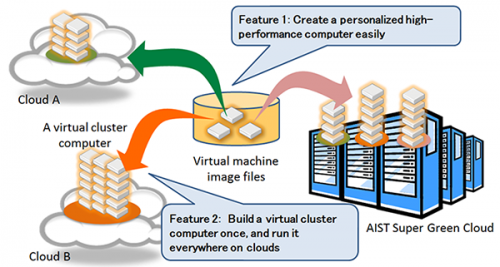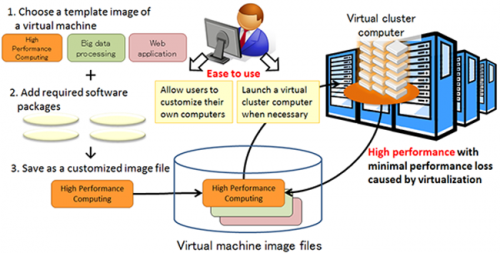High-performance computing crossing the barriers between clouds achieved

The Information Technology Research Institute of the National Institute of Advanced Industrial Science and Technology has developed a technology with which once an environment to perform high-performance computing has been established, a virtual cluster-type computer can easily be built on a different cloud and made available for immediate use.
Generally, in high-performance computing, cluster-type computers where many computers are bundled and run as a single computer are used. However, their hardware configuration is not uniform. On the other hand, virtual computers that are not dependent on hardware configuration are provided in clouds, and by bundling them together, a virtual cluster-type computer can be created. However, in this case, the user had to re-install software or reset the settings for a different cloud. Therefore, a technology to build a virtual cluster-type computer based on the design concept of "Build Once, Run Everywhere" has been developed. Once the environment to run the application has been established it may be run on any cloud, be it a private, commercial, or other cloud. Furthermore, since there are no constraints on the number of virtual computers that can be incorporated into the cluster, when the computing power is insufficient, an even larger virtual cluster-type computer can be formed on another cloud that allows the use of even more virtual computers, but allowing it to be used in exactly the same manner.
A virtual cluster-type computer was formed on AIST's private cloud, AIST Super Green Cloud (ASGC), and the ability to use it on Amazon EC2, a commercial cloud, was verified. With this technology, users and application fields that could not use high-performance computing previously can now use high-performance computing. Thus, the developed technology is expected to contribute to the enhancement of industrial competitiveness.
There are many research organizations and companies that require high-performance computing, such as in the development of automobiles and for drug discovery. Conventionally, each organization prepared cluster-type computers within their organization. This required the introduction of a system with even higher performance to solve problems exceeding its computing capacity. Further, it was not readily available for introduction when it was required.

In clouds now widely available today, computing performance can be increased through the addition of computers by bundling virtual computers to form a cluster-type computer. However, when the built environment is to be re-created on a different cloud, it required the software to be re-installed and the settings reconfigured, necessitating extra time, labor, and cost.
Furthermore, because initial introduction and operating costs for cluster-type computers are high, the environment for high-performance computing could not be maintained, especially for small- and medium-scale enterprises. Expansion of the fields in which high-performance computing can be applied in support of such users is required for the enhancement of industrial competitiveness.
AIST is conducting R&D aimed at achieving a high-performance computing infrastructure with both the convenience to run on any cluster-type computer once a high-performance computing application-executing environment has been created, and high computing performance. In the process, R&D was conducted under the concept of separating the application-executing environment from actual machines by virtualization using cloud technologies to establish cluster-type computers on various clouds as required. In addition, although a cloud is established with virtualization technology, in the field of high-performance computing, there has been an issue of a drop in computing performance when virtualized, which has hindered its popularization. Therefore, evaluation of the effects of virtualization when executing high-performance computing applications was conducted in detail and technologies to reduce the deterioration of performance caused by virtualization have been developed.
There are two main elements that comprise the developed technology to build virtual cluster-type computer. One is a mechanism to build and share a virtual computer image file that does not depend on the cloud, and the other is a mechanism to build a virtual cluster-type computer from the virtual computer image file. By using these technologies, a virtual cluster-type computer with a sufficient number of computers to match the scale of the computation can be built on various clouds. Specifically, with this technology, a virtual computer image file containing software and setting data common to all the virtual computers is transferred to virtual computers bundled in numbers required by the user, and by setting the information that is determined when the system is established, such as IP addresses to identify each computer or a list of the computers, a single cluster-type computer is formed. Software required for the development, execution, and monitoring of high-performance computing applications is pre-installed in the virtual computer image file, enabling the user to immediately start its use. In addition, because the user can freely customize the virtual computer image file, a personalized application-executing environment can be built (Fig. 1). This time, a virtual cluster-type computer was built on ASGC and using the same virtual computer image file, an even larger virtual cluster-type computer was built on Amazon EC2 and it was verified that it could be used in exactly the same manner.
Furthermore, the technology for the reduction of virtualization performance deterioration was developed and integrated into ASGC, and its effects were verified. Evaluation using High Performance LINPACK, a benchmark for high-performance computing, resulted in 6.77 TFLOPS for a non-virtualized cluster-type computer using 16 computers, against 6.40 TFLOPS for a virtualized cluster-type computer, an approximately 5 % deterioration in performance. Performance deterioration depends on the characteristics of the application. However, it has been confirmed that it is within acceptable range without any problems for practical use.
Currently available clouds only provide a single virtual computer and no virtual cluster-type computers are provided. Although there is software to build a virtual cluster-type computer on Amazon EC2, a commercial cloud, it is not configured to form an identical virtual cluster type computer on a different cloud. As far as we know, there is no high-performance computing cloud service other than the developed technology that enables the building of virtual cluster-type computers on different clouds. The developed technology enables multiple clouds to be used in accordance with necessity and opens up a path towards a new high-performance computing infrastructure.
The researchers will cooperate with academic clouds formed by universities and public organizations in Japan, as well as with research communities abroad, to conduct field tests concerning virtual cluster-type computers, and deploy it as an operational service on ASGC. Furthermore, the technology will be transferred to cloud services providers to expand users and the application fields of high-performance computing.
Provided by Advanced Industrial Science and Technology















